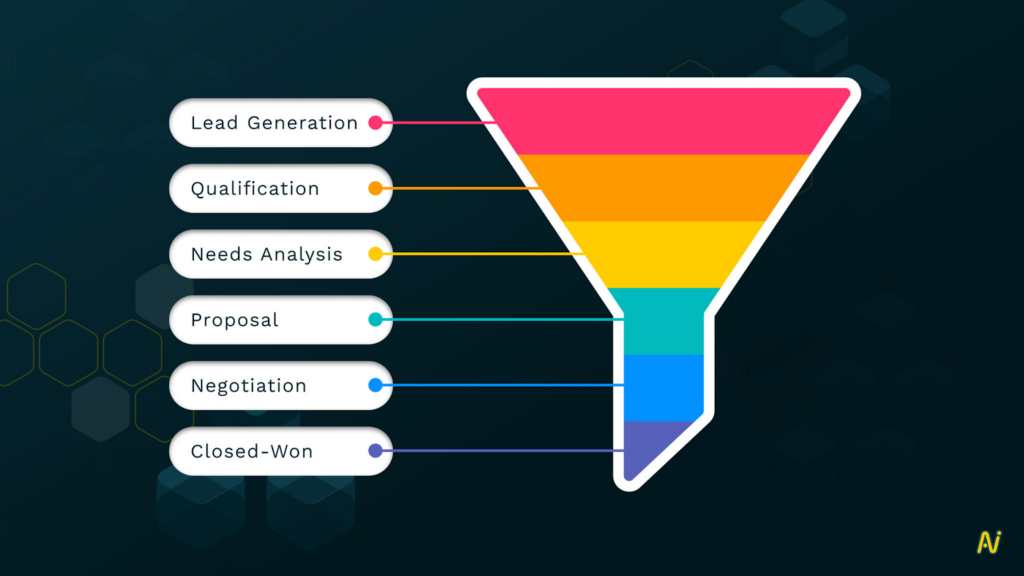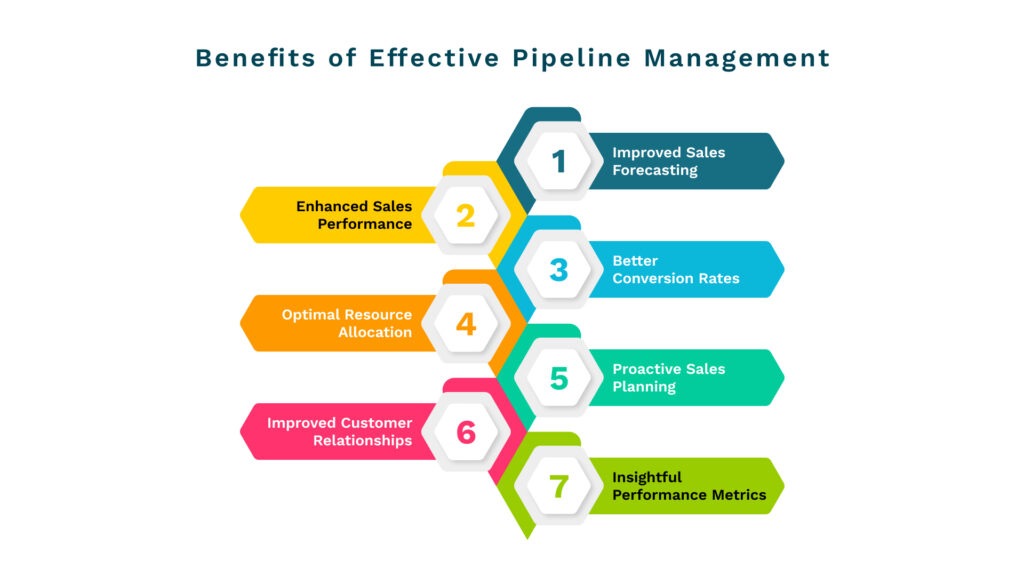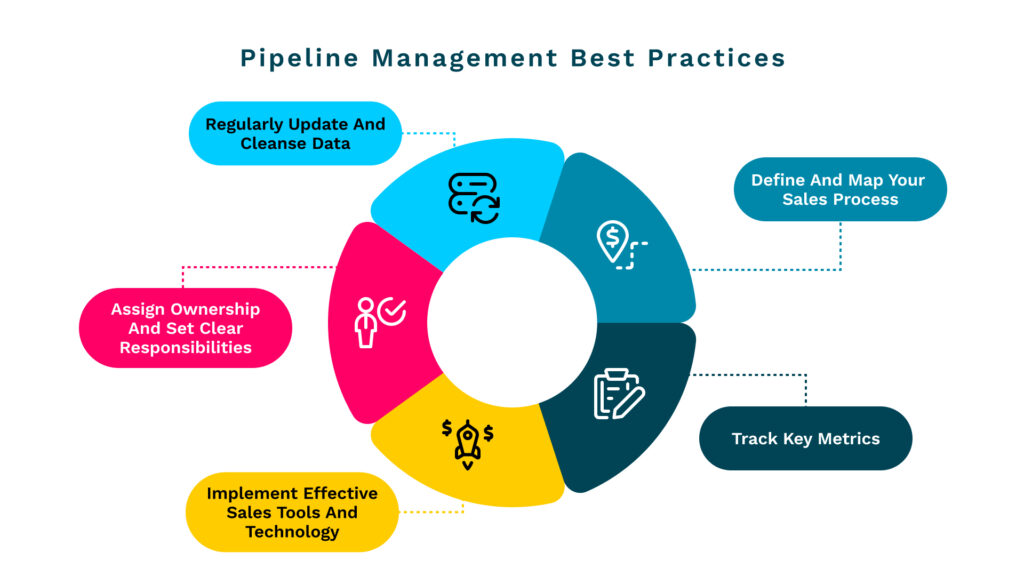Imagine a pipeline with numerous leaks and cracks along its length. Water escapes at various points, resulting in waste, reduced pressure, and an inefficient system.
Similarly, leads, opportunities, or tasks can be overlooked, lost, or delayed in inefficient pipeline management at different stages. This can result in missed revenue potential, reduced conversion rates, and poor performance.
Just as a leaky pipeline hampers the efficient flow of water, effective pipeline management hinders the smooth progression of sales or projects, positively impacting the organization’s success.
In this blog, we discuss what pipeline management is. What are its benefits? And what are some pipeline management best practices.

What is Pipeline Management?
Pipeline management is the practice of recognizing and overseeing the interconnected components involved in a company’s operations, ranging from production to sales. The most successful businesses excel at identifying the path of their financial resources and strategically allocating them to maximize productivity. This approach is commonly referred to as “pipeline management.”
Effective pipeline management involves the strategic and organized oversight of the sales or project pipeline, ensuring smooth progression and maximizing desired outcomes. It involves actively monitoring and managing leads, opportunities, or tasks through various stages, from initial contact to final conversion or completion.

Let’s have a look at some of the benefits of effective pipeline management:
Benefits of Effective Pipeline Management
Good pipeline management is crucial for optimizing sales performance and revenue growth by providing visibility into the pipeline, identifying potential bottlenecks, and enabling proactive decision-making to maximize conversion rates and drive business success.
Related Resource: Top 20 Best Pipeline Management Tools
Let’s have a detailed look at some of the benefits:
1. Improved sales forecasting
By diligently managing the sales pipeline, organizations gain better visibility into the upcoming revenue and can make more accurate sales forecasts. This allows for improved resource planning, budgeting, and overall business decision-making.
2. Enhanced sales performance
Pipeline management helps sales teams focus their efforts on high-potential opportunities and prioritize their activities accordingly. It enables sales representatives to identify and address bottlenecks or obstacles in the sales process, leading to increased efficiency, faster deal closures, and improved sales performance.
3. Better conversion rates
A well-managed pipeline ensures that leads move smoothly through the sales stages and receive the necessary attention and nurturing. This increases the likelihood of converting leads into customers, resulting in higher conversion rates.
4. Optimal resource allocation
Pipeline management helps organizations allocate their resources, such as salespeople, time, and budget, more effectively. It enables the identification of underutilized resources and allows for their reallocation to high-value opportunities, maximizing productivity and minimizing waste.
5. Proactive sales planning
By analyzing the pipeline, organizations can identify trends, patterns, and potential risks or opportunities. This empowers sales managers to proactively plan their strategies, set realistic targets, and make adjustments to optimize sales outcomes.
6. Improved customer relationships
Effective pipeline management emphasizes building and maintaining strong customer relationships throughout the sales process. By providing timely and personalized interactions, organizations can enhance customer satisfaction and loyalty, leading to repeat business and referrals.
7. Insightful Performance Metrics
Pipeline management provides valuable data and performance metrics, such as conversion rates, average deal size, and sales velocity. These metrics enable organizations to track and measure their sales performance, identify areas for improvement, and implement data-driven strategies.

With so many business benefits, it is no wonder that many organizations are now focussing on optimizing their sales pipeline. However, how can businesses achieve this? What are the best practices? Let’s go deep.
Pipeline Management Best Practices
Pipeline management involves basic principles such as establishing clear stages and milestones, maintaining consistent communication and collaboration, effectively prioritizing tasks, regularly monitoring progress, identifying and addressing bottlenecks. Here are a few ways companies can optimize their pipeline management:
1. Define and map your sales process
Clearly define the stages and steps of your sales process, from lead generation to deal closure. Map out the criteria and actions required to move prospects through each stage. This provides a structured framework for pipeline management.
2. Track key metrics
Monitor and analyze key metrics such as conversion rates, average deal size, and sales cycle length. These metrics provide insights into pipeline health, performance trends, and areas for improvement. Below are the few critical metrics to track:
- Lead-to-Opportunity ratio: This metric measures the percentage of leads that progress to the opportunity stage in your pipeline. It helps you understand the quality of your lead generation efforts and the effectiveness of your lead qualification process.
- Opportunity-to-Win ratio: It represents the percentage of opportunities that successfully convert into closed deals. It provides insights into your sales team’s ability to effectively move opportunities through the pipeline and close them successfully.
- Sales cycle length: The average time it takes to close a deal from the moment it enters the pipeline. It helps you identify potential bottlenecks or inefficiencies in your sales process and allows for more accurate sales forecasting.
- Average deal size: the average value of closed deals helps you understand the typical revenue generated per deal. It can assist in setting sales targets, resource allocation, and financial planning.
- Pipeline velocity: This metric measures the speed at which deals move through your pipeline. It takes into account the average time deals spend in each stage and the conversion rates between stages. Pipeline velocity helps identify areas where deals are getting stuck or where improvements can be made to accelerate the sales cycle.
3. Implement effective sales tools and technology
Leverage sales tools and technology, such as customer relationship management (CRM) systems, to manage and track your pipeline efficiently. These tools can automate tasks, provide real-time updates, and generate reports to streamline pipeline management.
4. Assign ownership and set clear responsibilities
Clearly define roles and responsibilities for each stage of the pipeline. Assign ownership of leads and opportunities to individual sales team members to ensure accountability and prevent prospects from falling through the cracks.
5. Regularly update and cleanse data
Keep your pipeline data up to date by regularly reviewing and updating lead and deal information. Remove outdated or irrelevant entries to ensure accurate insights and forecasts.
Inaccurate, incomplete, or inconsistent data can lead to errors, delays, and inefficiencies in decision-making and overall pipeline performance. Clean data thus becomes crucial for any sales pipeline’s performance. Let’s take a closer examination of the significance of clean data in pipeline management.

Clean Data as a Pipeline Management Best Practice
Clean data is crucial for effective pipeline management. It ensures accuracy and reliability throughout the process, enabling informed decision-making and reliable forecasting. With clean data, sales teams can allocate resources efficiently, track performance metrics accurately, and generate reliable reports. It forms the foundation for accurate pipeline visibility and streamlined sales processes.
Clean data also plays a key role in optimizing sales performance. It allows for comprehensive analysis of key metrics, such as conversion rates and sales velocity, leading to insights that drive targeted sales coaching and training initiatives. By maintaining clean data, organizations can maximize the effectiveness of their pipeline management, improve decision-making, and drive better sales outcomes.
Here are a few ways clean data aids in pipeline management:
- Ensures accurate sales forecasting
- Provides reliable pipeline visibility
- Enables effective decision-making
- Identifies bottlenecks and areas for improvement
- Enhances sales performance tracking
- Facilitates targeted and personalized engagement
- Improves customer relationship management
- Enables data-driven insights and analysis
- Supports resource allocation and planning
- Increases overall pipeline efficiency and effectiveness
To ensure clean data, many organizations have started implementing automation to their processes. Automation can validate data inputs, perform data cleansing and normalization tasks, identify and resolve inconsistencies or errors, and provide data quality checks at different stages of the pipeline.
By reducing manual intervention and human error, automation improves data accuracy, reliability, and consistency, thereby enhancing the overall quality of the pipeline management process.
Adopt the Right Tool as a Pipeline Management Best Practice
Automation and AI have the potential to transform pipeline management. They can automate lead generation and qualification, streamline CRM and data management processes, track sales activities, automate repetitive tasks, provide predictive analytics for accurate forecasting, optimize opportunity management, enable personalized customer engagement, and offer comprehensive sales performance analytics.
It is crucial to address risks proactively, understand successful strategies, expand their implementation across the sales team, and consistently replicate the process to advance deals from initiation to successful closure. Nektar is a unique solution that improves the integrity of CRM data, providing timely updates on pipeline progress to revenue leaders. This leads to a comprehensive and accurate understanding of the pipeline, free from any dilution.
Here is how Nektar is automating the sales pipeline:
- Effortlessly monitor the count of unengaged or dormant opportunities, ensuring that salespeople prioritize important, high-value deals and follow up promptly.
- Assess buyer-seller relationships, monitor weakly connected opportunities, and ensure sellers engage the entire buying committee consistently.
- Identify promising deals faster by tracking buyer engagement frequency with your sellers.
- Quickly identify stagnant deals that lack momentum in the same stage. Prompt guidance and executive intervention can revive these deals.
- Enhance forecast accuracy by identifying potential opportunity postponements in advance.
- Quantify activity count and frequency, along with buying committee coverage, throughout the sales cycle to establish benchmarks for optimizing sales cycles.
If you’d like to learn more, get in touch with us here.







